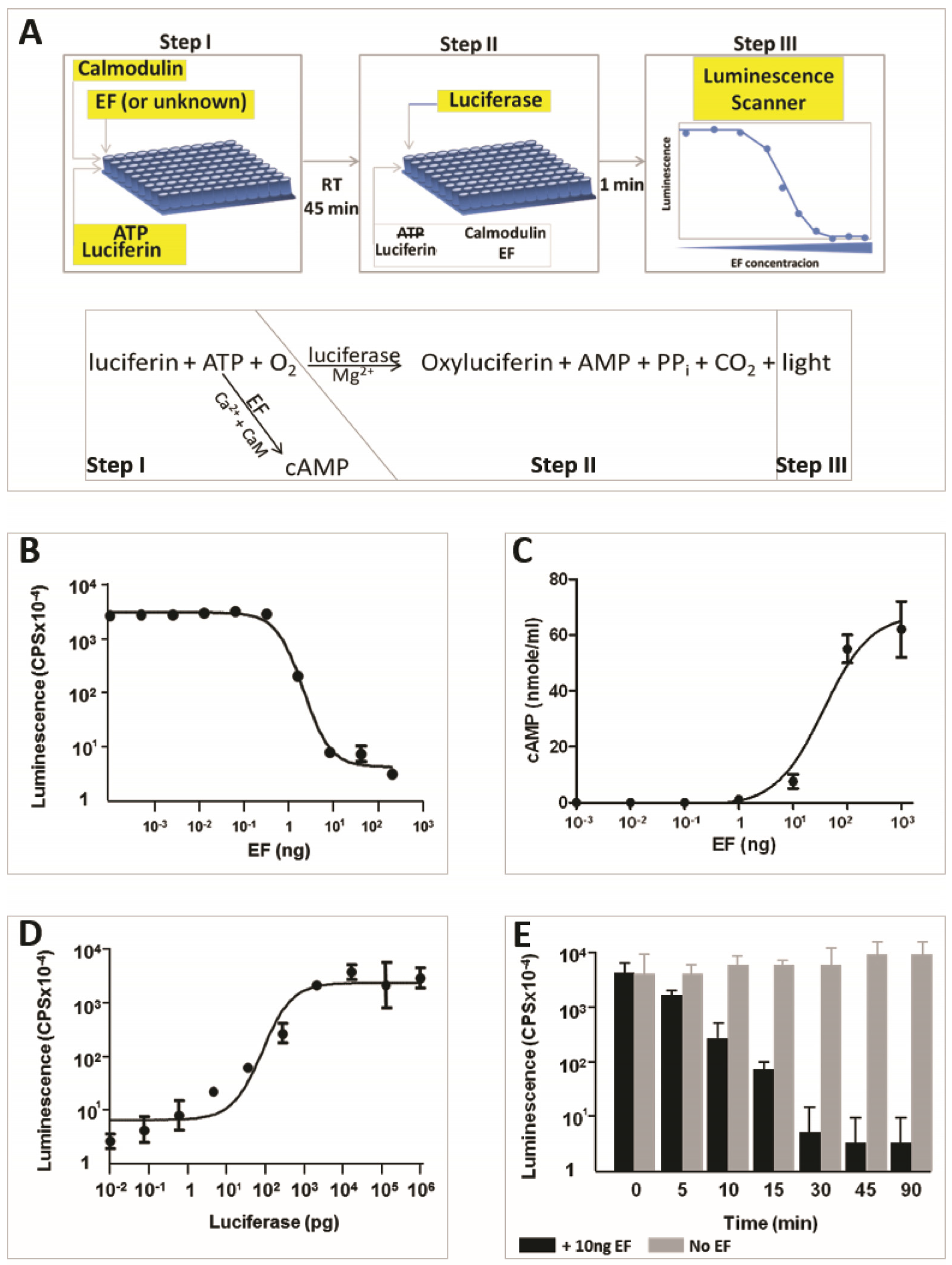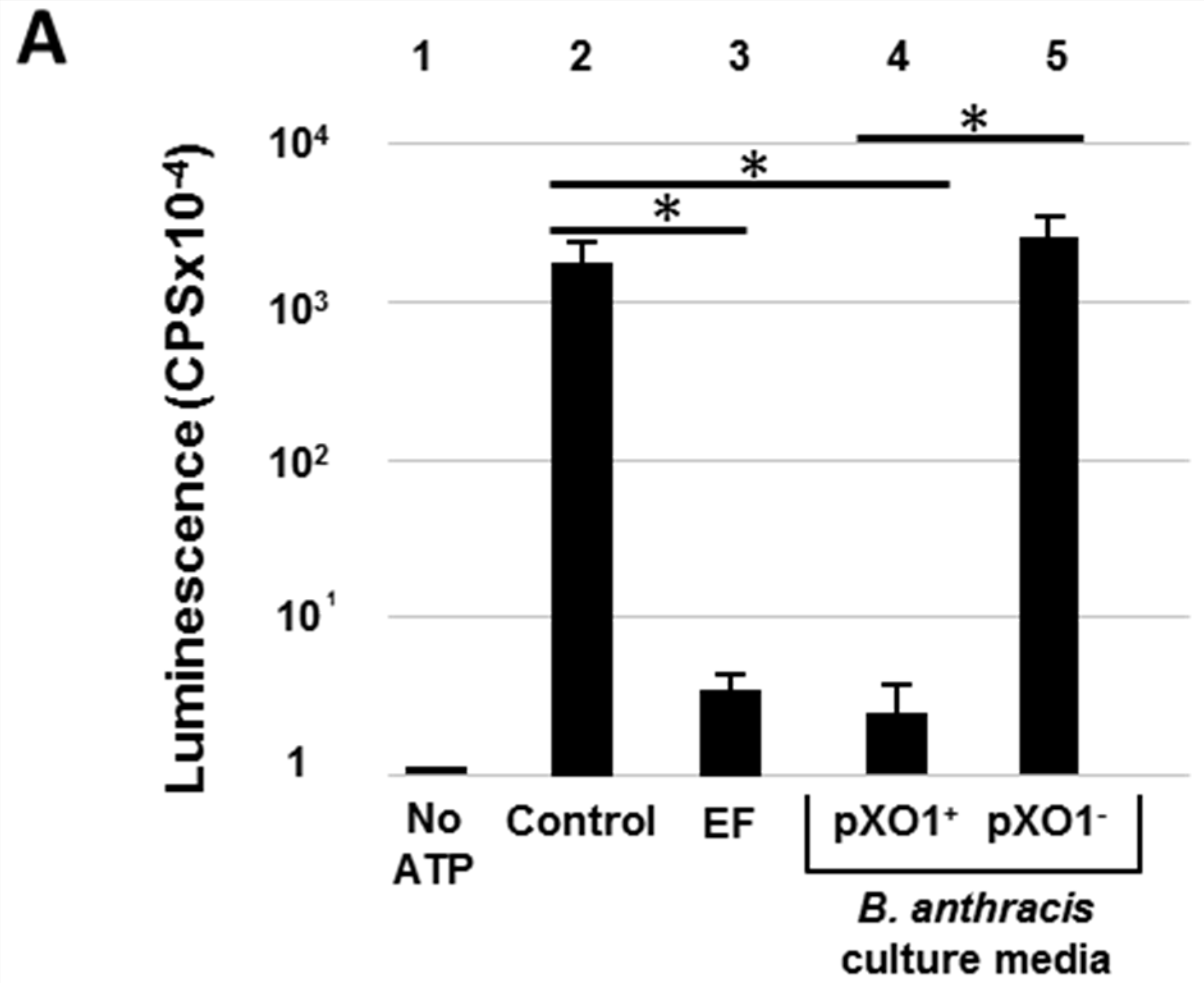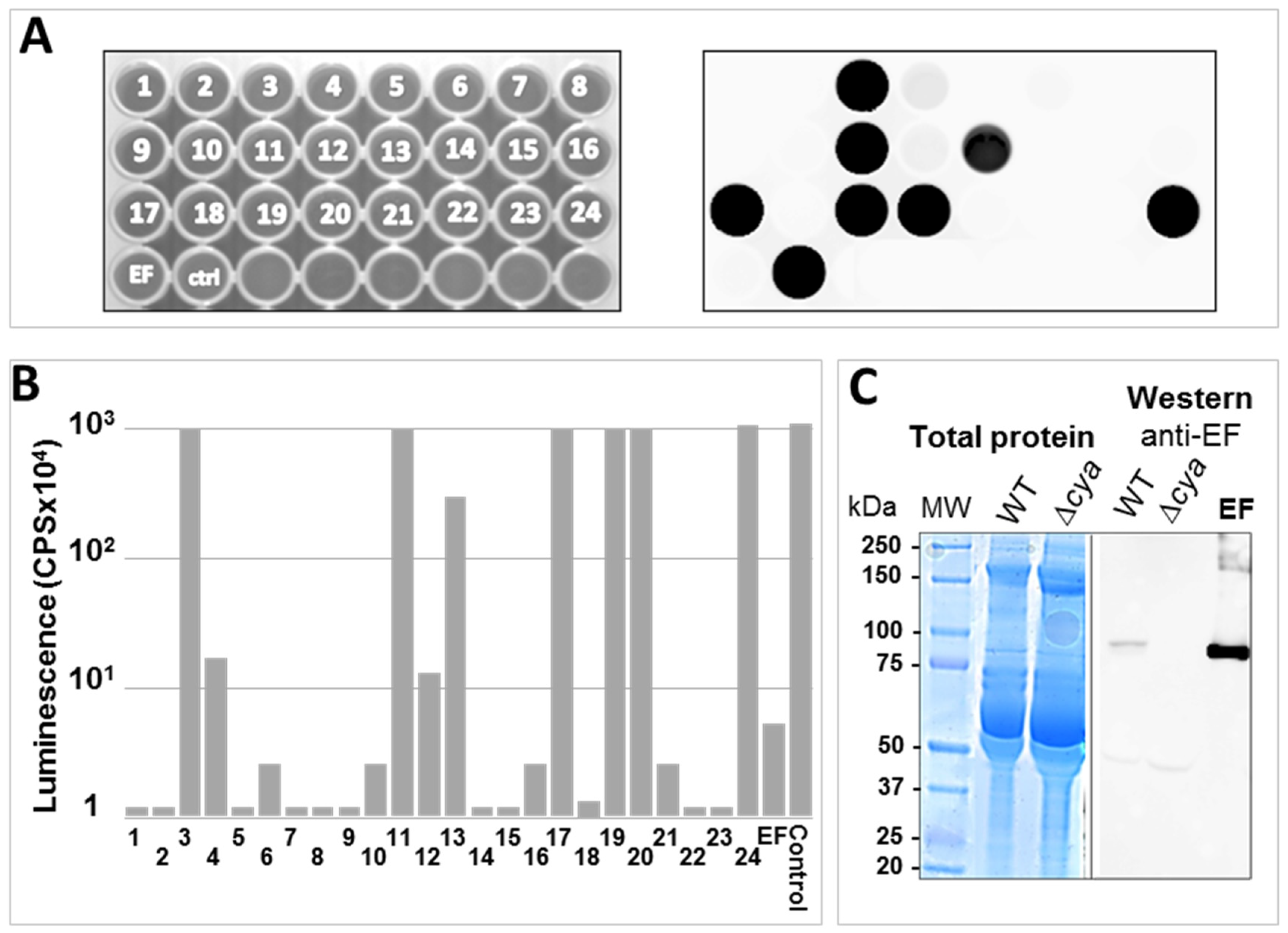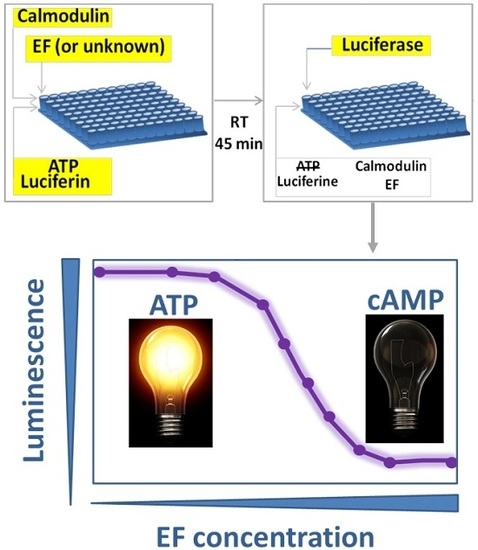A Simple Luminescent Adenylate-Cyclase Functional Assay for Evaluation of Bacillus anthracis Edema Factor Activity
Abstract
:1. Introduction
2. Results and Discussion
2.1. An ATP-Depletion Luminescence-Assay for Detection and Evaluation of the AC Activity of EF
2.2. Implementation of the EF-Mediated ATP-Depletion Luminescence-Assay for Evaluation of Active EF in Bacillus anthracis Cultures
2.3. Specific Reversion of EF Activity by Anti-EF Antibodies
2.4. Implementation of the ATP-Depletion Assay for Detection of EF-Mutated Bacteria
3. Experimental Section
3.1. Reagents
3.2. Bacterial Strains
3.3. Cultivation and Sampling
3.4. Adenylate Cyclase Assay
3.5. Western Blot Analysis
3.6. cAMP Quantification by ELISA
3.7. Data Analysis
Supplementary Materials
Acknowledgments
Author Contributions
Conflicts of Interest
References
- Baillie, L.; Read, T.D. Bacillus anthracis, a bug with attitude! Curr. Opin. Microbiol. 2001, 4, 78–81. [Google Scholar] [CrossRef]
- Blendon, R.J.; Benson, J.M.; DesRoches, C.M.; Pollard, W.E.; Parvanta, C.; Herrmann, M.J. The impact of anthrax attacks on the American public. MedGenMed 2002, 4, 1. [Google Scholar] [PubMed]
- Friedlander, A.M.; Welkos, S.L.; Ivins, B.E. Anthrax vaccines. In Anthrax; Koehler, T., Ed.; Springer: Berlin/Heidelberg, Germany, 2002; Volume 271, pp. 33–60. [Google Scholar]
- Leppla, S.H. Anthrax toxins. In Bacterial Toxins and Virulence Factors in Disease; Moss, J., Iglewski, B., Vaughan, M., Tu, A.T., Eds.; Marcel Dekker: New York, NY, USA, 1995; pp. 543–572. [Google Scholar]
- Mock, M.; Fouet, A. Anthrax. Annu. Rev. Microbiol. 2001, 55, 647–671. [Google Scholar] [CrossRef] [PubMed]
- Chitlaru, T.; Altboum, Z.; Reuveny, S.; Shafferman, A. Progress and novel strategies in vaccine development and treatment of anthrax. Immunol. Rev. 2011, 239, 221–236. [Google Scholar] [CrossRef] [PubMed]
- Koehler, T.M. Bacillus anthracis physiology and genetics. Mol. Asp. Med. 2009, 30, 386–396. [Google Scholar] [CrossRef] [PubMed]
- Lacy, D.B.; Collier, R.J. Structure and function of anthrax toxin. In Anthrax; Koehler, T., Ed.; Springer: Berlin/Heidelberg, Germany, 2002; Volume 271, pp. 61–85. [Google Scholar]
- Liu, S.; Moayeri, M.; Leppla, S.H. Anthrax lethal and edema toxins in anthrax pathogenesis. Trends Microbiol. 2014, 22, 317–325. [Google Scholar] [CrossRef] [PubMed]
- Moayeri, M.; Leppla, S.H.; Vrentas, C.; Pomerantsev, A.P.; Liu, S. Anthrax pathogenesis. Annu. Rev. Microbiol. 2015, 69, 185–208. [Google Scholar] [CrossRef] [PubMed]
- Leppla, S.H. Anthrax toxin edema factor: A bacterial adenylate cyclase that increases cyclic AMP concentrations of eukaryotic cells. Proc. Natl. Acad. Sci. USA 1982, 79, 3162–3166. [Google Scholar] [CrossRef] [PubMed]
- Collier, R.J. Membrane translocation by anthrax toxin. Mol. Asp. Med. 2009, 30, 413–422. [Google Scholar] [CrossRef] [PubMed]
- Gottle, M.; Dove, S.; Seifert, R. Bacillus anthracis edema factor substrate specificity: Evidence for new modes of action. Toxins 2012, 4, 505–535. [Google Scholar] [CrossRef] [PubMed] [Green Version]
- Bergman, N.H.; Anderson, E.C.; Swenson, E.E.; Janes, B.K.; Fisher, N.; Niemeyer, M.M.; Miyoshi, A.D.; Hanna, P.C. Transcriptional profiling of Bacillus anthracis during infection of host macrophages. Infect. Immun. 2007, 75, 3434–3444. [Google Scholar] [CrossRef] [PubMed]
- Edwards, K.A.; Clancy, H.A.; Baeumner, A.J. Bacillus anthracis: Toxicology, epidemiology and current rapid-detection methods. Anal. Bioanal. Chem. 2006, 384, 73–84. [Google Scholar] [CrossRef] [PubMed]
- Tang, W.J.; Guo, Q. The adenylyl cyclase activity of anthrax edema factor. Mol. Asp. Med. 2009, 30, 423–430. [Google Scholar] [CrossRef] [PubMed]
- Lubker, C.; Dove, S.; Tang, W.J.; Urbauer, R.J.; Moskovitz, J.; Urbauer, J.L.; Seifert, R. Different roles of N-terminal and C-terminal domains in calmodulin for activation of Bacillus anthracis edema factor. Toxins 2015, 7, 2598–2614. [Google Scholar] [CrossRef] [PubMed]
- Lubker, C.; Seifert, R. Effects of 39 compounds on calmodulin-regulated adenylyl cyclases AC1 and Bacillus anthracis edema factor. PLoS ONE 2015, 10, e0124017. [Google Scholar] [CrossRef] [PubMed]
- Dal Molin, F.; Tonello, F.; Ladant, D.; Zornetta, I.; Zamparo, I.; Di Benedetto, G.; Zaccolo, M.; Montecucco, C. Cell entry and cAMP imaging of anthrax edema toxin. EMBO J. 2006, 25, 5405–5413. [Google Scholar] [CrossRef] [PubMed]
- Duriez, E.; Goossens, P.L.; Becher, F.; Ezan, E. Femtomolar detection of the anthrax edema factor in human and animal plasma. Anal. Chem. 2009, 81, 5935–5941. [Google Scholar] [CrossRef] [PubMed]
- Rougeaux, C.; Becher, F.; Ezan, E.; Tournier, J.N.; Goossens, P.L. In vivo dynamics of active edema and lethal factors during anthrax. Sci. Rep. 2016, 6. [Google Scholar] [CrossRef] [PubMed]
- Greer, L.F., 3rd; Szalay, A.A. Imaging of light emission from the expression of luciferases in living cells and organisms: A review. Luminescence 2002, 17, 43–74. [Google Scholar] [CrossRef] [PubMed]
- Kricka, L.J. Clinical and biochemical applications of luciferases and luciferins. Anal. Biochem. 1988, 175, 14–21. [Google Scholar] [CrossRef]
- Roda, A.; Guarigli, M.; Michelini, E.; Mirasoli, M.; Pasini, P. Analytical bioluminescence and chemiluminescence. Anal. Chem. 2003, 75, 463A–470A. [Google Scholar] [CrossRef] [PubMed]
- Mock, M.; Ullmann, A. Calmodulin-activated bacterial adenylate cyclases as virulence factors. Trends Microbiol. 1993, 1, 187–192. [Google Scholar] [CrossRef]
- Chitlaru, T.; Gat, O.; Gozlan, Y.; Ariel, N.; Shafferman, A. Differential proteomic analysis of the Bacillus anthracis secretome: Distinct plasmid and chromosome CO2-dependent cross talk mechanisms modulate extracellular proteolytic activities. J. Bacteriol. 2006, 188, 3551–3571. [Google Scholar] [CrossRef] [PubMed]
- Chitlaru, T.; Gat, O.; Grosfeld, H.; Inbar, I.; Gozlan, Y.; Shafferman, A. Identification of in vivo-expressed immunogenic proteins by serological proteome analysis of the Bacillus anthracis secretome. Infect. Immun. 2007, 75, 2841–2852. [Google Scholar] [CrossRef] [PubMed]
- Koehler, T.M.; Dai, Z.; Kaufman-Yarbray, M. Regulation of the Bacillus anthracis protective antigen gene: CO2 and a trans-acting element activate transcription from one of two promoters. J. Bacteriol. 1994, 176, 586–595. [Google Scholar] [PubMed]
- Janes, B.K.; Stibitz, S. Routine markerless gene replacement in Bacillus anthracis. Infect. Immun. 2006, 74, 1949–1953. [Google Scholar] [CrossRef] [PubMed]
- Levy, H.; Weiss, S.; Altboum, Z.; Schlomovitz, J.; Glinert, I.; Sittner, A.; Shafferman, A.; Kobiler, D. Differential contribution of Bacillus anthracis toxins to pathogenicity in two animal models. Infect. Immun. 2012, 80, 2623–2631. [Google Scholar] [CrossRef] [PubMed]
- Levy, H.; Weiss, S.; Altboum, Z.; Schlomovitz, J.; Rothschild, N.; Glinert, I.; Sittner, A.; Kobiler, D. The effect of deletion of the edema factor on Bacillus anthracis pathogenicity in guinea pigs and rabbits. Microb. Pathog. 2012, 52, 55–60. [Google Scholar] [CrossRef] [PubMed]
- Molin, F.D.; Fasanella, A.; Simonato, M.; Garofolo, G.; Montecucco, C.; Tonello, F. Ratio of lethal and edema factors in rabbit systemic anthrax. Toxicon 2008, 52, 824–828. [Google Scholar] [CrossRef] [PubMed]
- Gentile, F.; Raptis, A.; Knipling, L.G.; Wolff, J. Extracellular cAMP formation from host cell ATP by Bordetella pertussis adenylate cyclase. Biochim. Biophys. Acta 1988, 971, 63–71. [Google Scholar] [CrossRef]
- Gentile, F.; Raptis, A.; Knipling, L.G.; Wolff, J. Bordetella pertussis adenylate cyclase. Penetration into host cells. Eur. J. Biochem. 1988, 175, 447–453. [Google Scholar] [CrossRef] [PubMed]
- Gottle, M.; Dove, S.; Steindel, P.; Shen, Y.; Tang, W.J.; Geduhn, J.; Konig, B.; Seifert, R. Molecular analysis of the interaction of Bordetella pertussis adenylyl cyclase with fluorescent nucleotides. Mol. Pharmacol. 2007, 72, 526–535. [Google Scholar] [CrossRef] [PubMed] [Green Version]
- Yahr, T.L.; Vallis, A.J.; Hancock, M.K.; Barbieri, J.T.; Frank, D.W. ExoY, an adenylate cyclase secreted by the Pseudomonas aeruginosa type III system. Proc. Natl. Acad. Sci. USA 1998, 95, 13899–13904. [Google Scholar] [CrossRef] [PubMed]
- Chitlaru, T.; Israeli, M.; Bar-Haim, E.; Elia, U.; Rotem, S.; Ehrlich, S.; Cohen, O.; Shafferman, A. Next-generation Bacillus anthracis live attenuated spore vaccine based on the htrA− (high temperature requirement A) Sterne strain. Sci. Rep. 2016, 6. [Google Scholar] [CrossRef] [PubMed]
- Chitlaru, T.; Zaide, G.; Ehrlich, S.; Inbar, I.; Cohen, O.; Shafferman, A. HtrA is a major virulence determinant of Bacillus anthracis. Mol. Microbiol. 2011, 81, 1542–1559. [Google Scholar] [CrossRef] [PubMed]
- Chitlaru, T.; Israeli, M.; Bar-Haim, E.; Elia, U.; Rotem, S.; Ehrlich, S.; Cohen, O.; Shafferman, A.; Israel Institute for Biological Research, Ness-Ziona, Israel. Unpublished Work. 2015.




© 2016 by the authors; licensee MDPI, Basel, Switzerland. This article is an open access article distributed under the terms and conditions of the Creative Commons Attribution (CC-BY) license (http://creativecommons.org/licenses/by/4.0/).
Share and Cite
Israeli, M.; Rotem, S.; Elia, U.; Bar-Haim, E.; Cohen, O.; Chitlaru, T. A Simple Luminescent Adenylate-Cyclase Functional Assay for Evaluation of Bacillus anthracis Edema Factor Activity. Toxins 2016, 8, 243. https://doi.org/10.3390/toxins8080243
Israeli M, Rotem S, Elia U, Bar-Haim E, Cohen O, Chitlaru T. A Simple Luminescent Adenylate-Cyclase Functional Assay for Evaluation of Bacillus anthracis Edema Factor Activity. Toxins. 2016; 8(8):243. https://doi.org/10.3390/toxins8080243
Chicago/Turabian StyleIsraeli, Ma’ayan, Shahar Rotem, Uri Elia, Erez Bar-Haim, Ofer Cohen, and Theodor Chitlaru. 2016. "A Simple Luminescent Adenylate-Cyclase Functional Assay for Evaluation of Bacillus anthracis Edema Factor Activity" Toxins 8, no. 8: 243. https://doi.org/10.3390/toxins8080243






